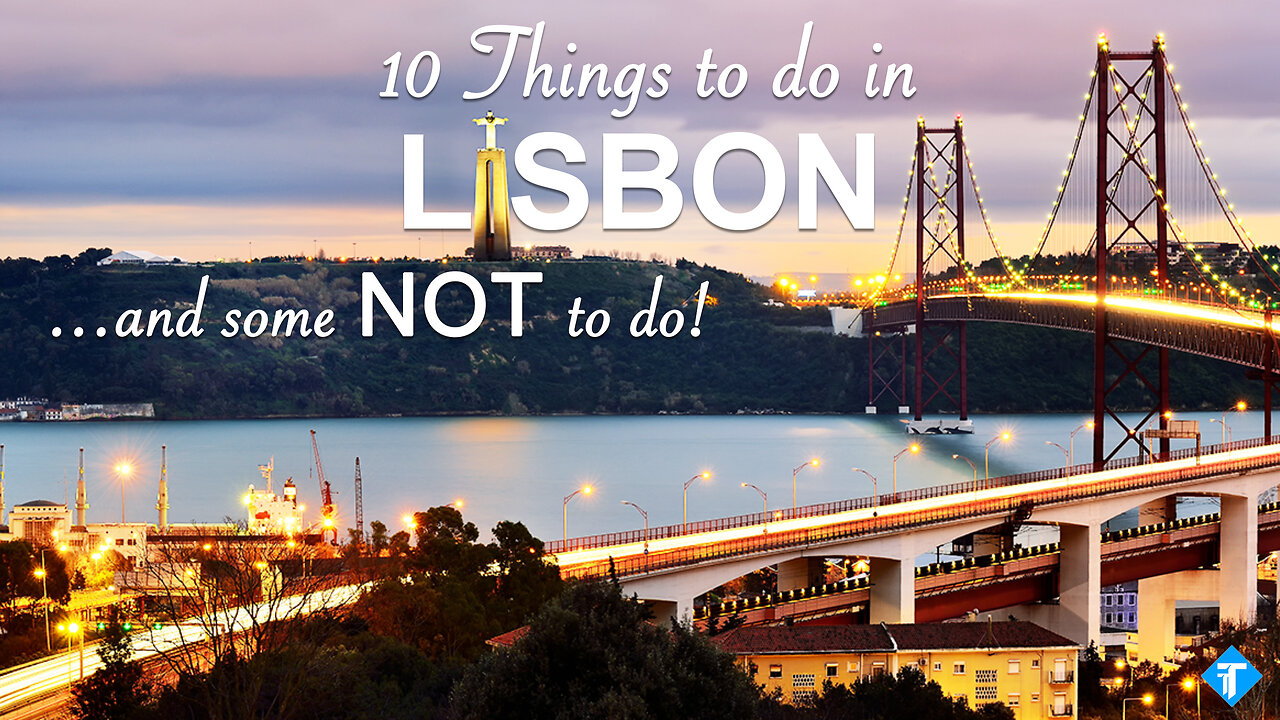Premium Only Content

11 things to do (and also some not to do) in Lisbon - 2023 Portugal Travel Guide
In the history of Lisbon there are several "before" and "after". The most important event was certainly the earthquake of 1 November 1755 when a series of violent shocks, followed by a tsunami, destroyed a large part of the city. In addition to the enormous political implications for a colonial power such as Portugal in the 18th century, the Lisbon disaster sparked heated debate across Europe. There were even those who interpreted the catastrophe as a divine punishment for the forced evangelization of the Indians in South America. The fact is, however, that from the rubble of the earthquake emerged a city even more beautiful than it was, with a sui generis charm that in the following centuries was an inexhaustible source of inspiration for artists and writers.. The successful democratic transition, in addition to returning the Portuguese nation to Europe, gave Lisbon back the international prestige it deserved, and which still characterizes it today compared to the rest of the country. Now we see together some of the most beautiful things to visit in the city. Good vision.
1 Baixa
At the beginning we referred to the earthquake of 1755 and to the fact that the city rose from the rubble more beautiful than before. Given this premise, a visit to Lisbon can only start from La Baixa, by far the district most affected by the earthquake and where traces of the reconstruction carried out by the then Prime Minister Sebastião José de Carvalho e Melo, Marquis of Pombal. It is no coincidence that the district soon took on the name of "Baixa Pombalina" precisely in deference to the new characteristics with which the architects appointed by the Marquis replaced any residue of medieval Lisbon. More functional and less aesthetic architectural features, but equally able to give a harmonious balance to the whole neighborhood, full of alleys and secondary streets. Do not miss Praça do Comércio ("Commerce Square" in English) in the center of which stands the imposing equestrian statue of Joseph I, the king who entrusted the difficult task of reconstruction to the Marquis of PombaI. Praça Dom Pedro IV, better known as "Rossio", is also very beautiful.
2 Trams 28
Although not a tourist train, the Electrico 28 is one of the best-known postcard images of Lisbon. Therefore, one cannot say that one has visited the city without at least one ride on one of these characteristic yellow vintage trams that go up and down from Praça Martim Moniz and Campo Ourique, the two terminus that cover a journey of about 40 minutes . A journey during which it is advisable to try to stay as close as possible to the windows, to admire the details and glimpses that the city offers in large quantities. According to most, the stretch of line that crosses the Alfama (one of the main districts of Lisbon) is the most evocative of the whole route. The advice is to go up to one of the two terminus to be more likely to find a seat. Tram 28, in fact, is always very crowded and you can really find everything on board, including (sometimes) pickpockets and daredevil kids without a ticket.
3 Santa Justa Elevator
There is not only Tram 28 to take. Even the Santa Giusta lift is certainly worth a visit. The "elevadores" are a feature of Lisbon, one of the ways in which the inhabitants of the Portuguese capital have avoided the effort of walking up and down the steep city streets. Compared to the others, however, the Elevador de Santa Justa is a real work of art. Built between 1898 and 1902 by the architect Raul Mesnier, this lift is a liberty jewel, moreover inserted in an equally precious architectural context such as the eighteenth-century "Baixa Pombalina". A spectacular Lisbon skyline awaits you at the top. The only advice is to move early in the morning to avoid the long lines that inevitably dampen the enthusiasm of the discovery. Not to be missed!
4 Alfama
If Baixa is the symbolic district of the rebirth of Lisbon, Alfama preserves its popular spirit. In ancient times, the district developed outside the medieval walls, hosting the part of the population excluded from the trades and comforts of the fortified citadel. Even after the Middle Ages this remained the main feature of the area, mainly inhabited by dockers and sailors. From this social mix arose the urban aspect of the neighborhood made up of winding streets, stairways (calcadas in Portuguese), flowered balconies and clothes hanging in the sun. A popular environment, in fact, in which it is wonderful to immerse yourself as soon as you get off that previously mentioned tram 28. In Alfama, among other things, there is really a lot to see: from the Cathedral, to the Castle up to the Roman ruins (Museo do Teatro Romano) a visit to this part of Lisbon will not leave you indifferent. Seeing is believing.
5 Cathedral of Santa Maria Maggiore
Built in 1150 on the site of a previous mosque, the Cathedral of Santa Maria Maggiore, better known by the abbreviation of "Sé" (sede episcopalis), is the main Catholic place of worship in the whole city. Over the centuries it has undergone various transformations, mostly due to the need to deal with the shocks caused by the earthquakes of the fourteenth century, and above all by the more famous one of 1755. This is briefly explained why the facade is in Romanesque style, while inside we find chapels in Gothic style and the main apse, however, with an unmistakable Baroque style. The imposing crenellated towers warn the visitor of the location of the church. The circular rose window above the entrance portal is also very beautiful. The advice is to go all around the building to admire the sculptures (gargoyles) that decorate the external walls.
6 Castle of San Giorgio
In every large city there is a monument which, more than any other, summarizes the history of the entire territory. In Lisbon, it is the Castle of São Jorge, in the Alfama district, that has this characteristic. Built by the Visigoths in the 5th century BC, the fortress was considerably reinforced during the rule of the Moors. In fact, the soldiers who had the task of defending the city (especially the ruling Muslim elite) from the menacing advance of Alfonso Henriques stayed there. A circumstance that actually occurred in 1147, when the king of Portugal managed to expel the Moors from Lisbon with the decisive help of the Anglo-Norman fleet directed to the Holy Land. From the fourteenth century, to be precise from 1371, the dedication to St. George, patron saint of England, wanted by King John I husband of the English noble Philippa of Lancaster. In the eighteenth century, however, although greatly altered, the castle survived the terrible earthquake that struck the Portuguese capital. Since then there have been no significant changes in the history of this fortress which, however, with the advent of tourism, has quickly turned into one of the main attractions of Lisbon. To see, the permanent exhibition with the innumerable finds found in the area over a vast period of time, from the 7th century BC. C. to the post-earthquake of 1755.
7 Convent of Carmo
Not far from the Castle of San Giorgio, the Convento do Carmo is another unmissable stop on a visit to Lisbon. The charm of this convent dedicated to "Nossa Senhora do Vencimento do Monte do Carmo" lies in its ruined condition. A condition that has persisted since 1755, the year in which, as we have seen, a terrible earthquake destroyed the city. So almost 300 years of abandonment even if, to tell the truth, it is only the church that has never been restored, while the premises of the Carmelite convent have long since been transformed into a museum by the Portuguese Archaeological Association. The fact remains, without detracting from the Roman, Visigothic and pre-Columbian remains kept in the rooms of the Museo Arqueologico do Carmo, that the arches and pillars of the Gothic church are the most suggestive element for the many tourists who visit the site every day. So be careful not to forget your camera. Like the Tower of Belém which we will discuss later, the light gray of the arches, coats of arms and other pieces of the ruined nave go very well with the blue of the sky. Not to be missed!
8. Bairro Alto
After visiting the Convento do Carmo, the most culturally significant site in the whole Bairro Alto, we are going to take a walk through the narrow and uphill alleys of the neighborhood. In this case, the first thing that catches the eye is the rationality with which the streets were designed in opposition to the "spontaneity" of the Alfama. The urban differences reflect those of class, even if the different social composition over time has become decidedly more nuanced, until it disappears completely. To say, in the narrow streets of Cais do Sodrè south of the Bairro, for years the main activity was prostitution. Only recently has there been a radical cleaning up of the area, transforming what was once a degraded corner of the city into the heart of Lisbon's nightlife (this should be extended to the entire neighborhood). Bairro alto, in fact, is the neighborhood where there is the greatest concentration of restaurants, bars and clubs where it is very pleasant to stop and eat, drink and listen to music. Especially the fado, the traditional Portuguese music not surprisingly under UNESCO protection. Absolutely not to be missed is Miradouro de São Pedro de Alcantara, a wonderful panoramic point that can be accessed by funicular (Elevador da Gloria) or on foot.
9 Tower of Belém
In Lisbon there is the "Pombaline" and the "Manueline" style. The first, as we have seen, refers to the architectural legacy of the Marquis of Pombal, architect of the reconstruction of the city after the terrible one-two, earthquake plus tidal wave, which destroyed Lisbon on 1 November 1755. With the "Manueline" style, however, we refer to the works created during the reign (1495 -1521) of Manuel I of Portugal (1469 - 1521). Together with the Monastery of San Geronimo (see next paragraph), the Tower of Belém is the most precious testimony of this mix between late Gothic and Renaissance designed to celebrate the colonial power of Portugal. It is no coincidence that the fortress is a UNESCO World Heritage Site even if, unlike the Monastery of San Geronimo, it is above all the exterior, rich in stone decorations, that bears traces of more sophisticated solutions from an architectural point of view. The interior, on the other hand, leaves less room for creativity, in line with the defensive function of this tower built on the bank of the Tagus River. Ultimately, therefore, the Tower of Belém certainly deserves a visit, bearing in mind however that the greatest suggestions are due to the interaction with the wonderful surrounding context.
10 Monastery of San Girolamo
If you need a blue sky or a summer twilight to enhance all the beauty of the Tower of Belém, the Mosteiro dos Jerónimos (so called because until 1833 it was run by the monks of the order of San Girolamo) needs no details atmospheric conditions to shine. We are in the presence of the most impressive symbol of Portugal's power during the so-called "Age of Discovery". Manuel I had the monastery built on the site of an old hermitage where, in 1502, Vasco da Gama had spent the last night with his fleet before setting sail for the Indies. That expedition ensured Portugal's monopoly on the spice trade, and therefore celebrating the enterprise worthily was an absolutely due act for the King. To do this, he ordered the architect Doigo Boitaca to build this beautiful monastery in which everything - from the church to the southern portal via the cloister - truly has something of a fairytale. Finally a curiosity. In 1985, on the fiftieth anniversary of his disappearance, the remains of Fernando Pessoa (1888 -1935), one of the greatest Portuguese poets and writers of the 20th century were moved inside the monastery near those of Vasco da Gama and Luís de Camões, universally considered the main Portuguese poet. For more information on timetables, prices and activities that take place inside the monastery (which, we recall, is a UNESCO World Heritage Site).
11 Oceanarium
If you like aquariums you should definitely visit the one in Lisbon. Bull sharks, puffer fish, sunfish, puffins, penguins, sea otters and many other species are present in this aquarium which is located inside the Nations Park (Parque das Nações in Portuguese), a residential area of the city in conjunction with EXPO 1998. In terms of size, the Oceanário de Lisboa is second only to the Acquario di Valencia and competes with that of Genoa. In short, truly an opportunity not to be missed, especially if you travel with children in tow. The only precaution is to buy tickets online directly on the aquarium website to avoid the queues at the entrance.
Warning 1. Beware of pickpockets
It is a topic we have already mentioned when talking about Tram 28, but it also applies to the other lines. Don't worry though. A few simple tricks, such as avoiding keeping your wallet in your back pocket and, more generally, showing off valuables, and there's nothing else to fear.
Warning 2. Be careful when choosing a restaurant
That of "tourist traps" is a topic that we have already addressed when talking about Rome. The phenomenon is also present in Lisbon, so the advice is to pay due attention to the choice of restaurant. In the case of the Portuguese capital, you would do well to doubt the formulas "food plus fado show", as well as all those places where the classic "buttadentro" is at the door inviting potential patrons to enter. Today, however, it is not difficult to take measures on these aspects, just read the reviews in advance or, if there is a way, ask for advice from someone who has visited the city previously. Better yet, ask someone local for advice.
Warning 3. Don't just visit museums and monuments
Without detracting from art, culture and local history, Lisbon is also a city where it is nice to be outdoors, discovering its countless architectural details and panoramic views. For this reason we did not dwell too much on museums and other points of interest which would have deserved a mention (above all the Palace of Sintra, a UNESCO World Heritage Site). Obviously nothing prevents you from acting differently, perhaps with the "spirit" invoked just now: letting yourself be guided by the city, without necessarily planning every aspect of your holiday.
-
 19:38
19:38
Neil McCoy-Ward
9 hours agoMASS LAYOFFS Have Started... (How To Protect Your Income)
13.8K5 -
 46:21
46:21
PMG
21 hours ago"Venezuelan Gang in 16 States, Animal Testing Crackdown, & Trump’s Nominee Battle"
6.97K2 -
 LIVE
LIVE
VOPUSARADIO
8 hours agoPOLITI-SHOCK! WW3!?, BREAKDOWN OF THE WORLD EVENTS & R.A.G.E. (What it means & What's next!)
83 watching -
 1:00:10
1:00:10
The StoneZONE with Roger Stone
5 hours agoWhy Democrats Hold Poor Children Hostage in Failing Schools | The StoneZONE w/ Roger Stone
34.9K3 -
 LIVE
LIVE
Tundra Gaming Live
5 hours ago $0.50 earnedThe Worlds Okayest War Thunder Stream//Air Force Vet Flys Jets
145 watching -
 2:00:54
2:00:54
Redacted News
7 hours agoBREAKING! Putin just SHOCKED the world, launches nuclear capable warheads "NATO can't stop it"
170K489 -
 55:37
55:37
Candace Show Podcast
6 hours agoMatt Gaetz Out, Jussie Smollett Walks Free! | Candace Ep 108
133K322 -
 54:43
54:43
LFA TV
1 day agoTrump Has Learned His Lesson | Trumpet Daily 11.21.24 7PM EST
31K8 -
 1:02:42
1:02:42
theDaily302
13 hours agoThe Daily 302-Special Border Invasion Shutdown Show
19.3K2 -
 4:29:05
4:29:05
Tate Speech by Andrew Tate
14 hours agoEMERGENCY MEETING EPISODE 92 - IN THE TRENCHES
779K1.34K